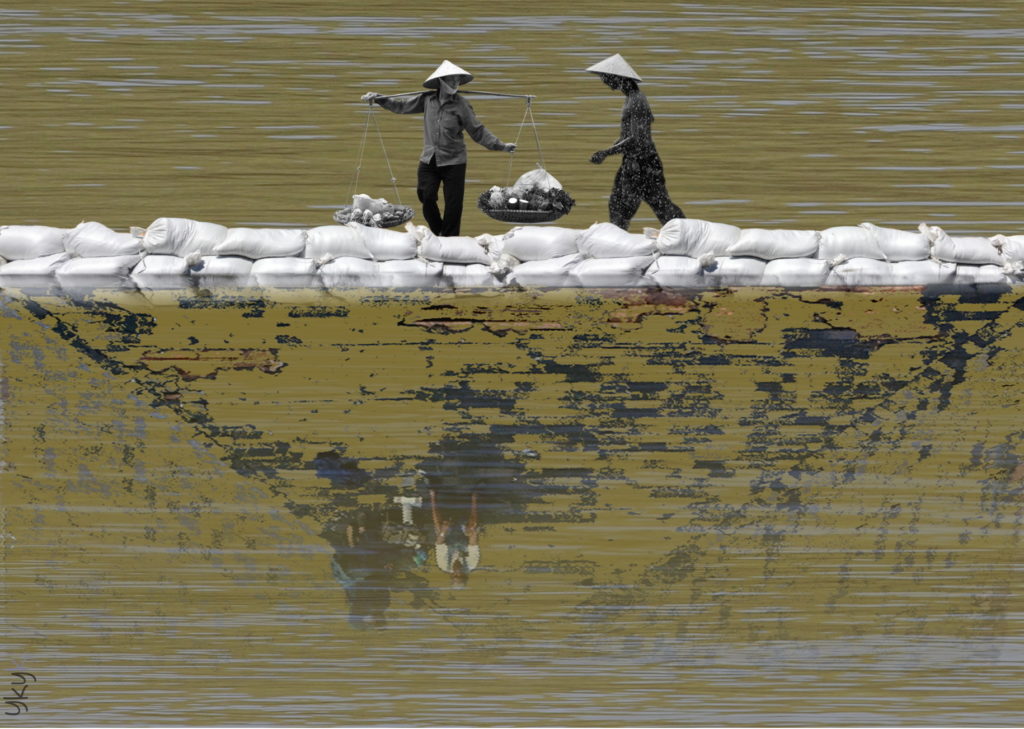Katrina was one of the most destructive natural disasters (*) to strike the US. The reasons of the malfunctions which turned the city into chaos are well known. But what have we learned from the flooding? Some pending questions remain: Did New Orleans resilience improve? Did other cities threaten by flooding learn from this tragic event? Obviously, the significant funding received by the city led to a number of positive initiatives. Ranking from mitigation to adaptation, they aim to fulfill both engineering and socio-ecological resilience objectives. The strategy has been elaborated. It is structured and impressive (1)(2). And there is no reason to doubt of the local administration willingness to build a safer future for the city. Unfortunately, increasing the ability to effect change and “live with water” takes time. The most concerned are those who are potentially the most affected: poor people, with a household income below $ 20 000 pa, living in the most vulnerable places. Persuading them to return to the location they left is challenging with no real mean and social support for rebuilding “Lower ninth ward”, the poorest area (3)
A well-documented article published by J. Leroy & Al (4) underlines the differences of behavior between two communities that were both affected by Katrina. By the spring 2007, more than 90 % of the Vietnamese community was back in the neighborhood where less than 50 % of the Black American was. Indeed, in the Vietnamese community, social resilience made the difference with a structured group, a cultural capital and an outstanding ability for self-organization.
Yes, people are more committed, and for some of them maybe empowered. But is there any evidence showing that the poorest will take advantage of the city initiatives to decrease their social vulnerability? Any sign of improved social cohesion? Is New Orleans resilient even if some of its component neighborhoods remain half-empty?
I.Maret / T.Cadoul (3) recall how vibrant and dynamic the culture of “Big Easy” was prior to Katrina. Is this lost forever? The administration responsibility is huge, be it in New Orleans or in any city threaten by flooding. Is the Houston plan in favor of massive tunnels to carry away stormwater instead of expanding flood zones the most appropriate (5)? If a new Katrina occurs, whatever the place, shall we see again one community back to work while the other will wait for rescue on the roofs?
(*) The words “natural disasters” are here used in the very wide sense of the term, covering both hurricane and floods. But as recalled by LJ Vale (5), the disaster was deeply implicated in societal choices about infrastructure location, residential development patterns and disaster recovering priorities. Local decision makers cannot escape responsibility on the ground that hurricanes cause can be seen as “natural”.
Yky, April 2019, yky@resi-city.com

- http://resilientnola.org/
- https://www.100resilientcities.org/new-orleans-resilience-strategy-release/
- https://doi.org/10.3917/ag.663.0104
- https://www.e3s-conferences.org/articles/e3sconf/pdf/2016/02/e3sconf_flood2016_08002.pdf
- https://www.chron.com/news/politics/houston/article/Flood-control-district-exploring-plan-to-build-12776323.php
Regarding Hurricane Katrina as a ‘natural disaster’, even ‘in the very wide sense of the term’, please see http://understandingkatrina.ssrc.org/Smith
Along similar lines, in using the term resilience and peculiar variations such as “socio-ecological resilience”, some critiques might be of interest, with a few examples being:
1. https://doi.org/10.5194/nhess-13-2707-2013
2. https://doi.org/10.1108/09653561311301970
3. https://doi.org/10.1108/DPM-12-2012-0143
4. https://doi.org/10.1111/area.12118
5. https://doi.org/10.1007/s11069-016-2294-0
6. https://acme-journal.org/index.php/acme/article/view/866
7. https://doi.org/10.1177/0309132513518834
8. https://doi.org/10.1108/DPM-03-2013-0053
9. http://www.ilankelman.org/articles1/kelman2008udp.pdf
10. https://doi.org/10.1007/s13753-015-0038-5
11. https://doi.org/10.1108/09653560710817011
12. https://doi.org/10.1080/13549839.2011.583049
13. http://www.daghammarskjold.se/wp-content/uploads/2012/04/dd58_one_side.pdf (the article starting on page 67).
Bringing together these two points for Katrina, see http://www.noladefender.com/content/dont-call-me-resilient and https://doi.org/10.1177/0956247816684763 especially with regards to lessons relearned from Katrina http://dx.doi.org/10.5055/ajdm.2008.0009
With thanks and best wishes,
Ilan
Twitter/Instagram @ILANKELMAN
Thank you so much Ilan for contributing with all those publications. As you underline, there is a threat of neglecting the fundamentals of resilience and vulnerability, certainly nowadays that climate change focuses on hazards mitigation without acknowledging our collective responsibility in the world we have built. And regarding Katrina, the article of Neil Smith (for members of the list, the first one mentioned by Ilan) is so self-speaking! The article “don’t call me resilient” makes me very sad. I have a wishful and naïve dream. One day, all of us will realize that more important than concepts, the ultimate objective is the well-living and well-being of people together. Citizens will be empowered and will ask experts and decision makers: what have you done to fulfill your duty. Trying to put in pictures how to think resilient is quite challenging. I try to make my work as pedagogic as possible for my other fellow-citizens, thereof sometimes a bit simplistic. I would like to do more. But it’s the only thing I can do. Thanks again. Yky.